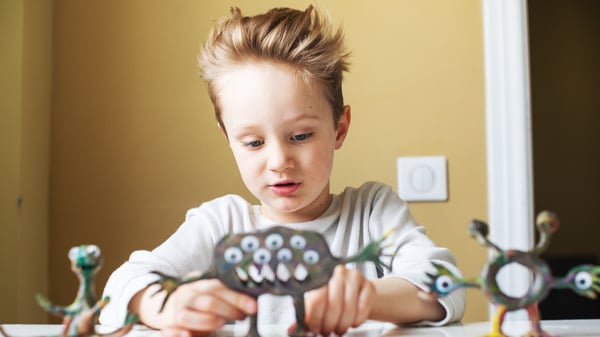3 min read
Online Art Education: Overcoming the Hurdles Part 1
By: Nicole Rimbey on May 27, 2020 2:48:50 PM

The COVID-19 pandemic has shaken education dramatically. Students and teachers alike are now confined to learning and teaching within the walls of their own home, given no choice in the matter.
The challenges art educators are facing vary from district to district as well as from student to student. To provide support to the art education community, our team of online art educators gathered a list of challenges identified by local brick-and-mortar art educators. They generated thinking points to address those challenges in our two-part blog series.
While these challenges and solutions are not all encompassing, they are meant to provide help and hope to the nation’s creative-minded leaders and enable them to overcome their most debilitating hurdles. Part 1 of our series addresses concerns surrounding the immediate transition to online learning.
Limited Supplies and Lack of Access to Specialized Equipment
Planned art projects and expectations need to shift. Instead of focusing on the use of unattainable supplies and equipment, think about introducing and reinforcing different skills that all artists must have in order to be successful: observation, research, planning, experimentation, spontaneity, the act of editing or revising.
You can still teach your printmaking unit, but in place of the press, students can use a spoon, explore monoprinting, create tiny eraser printing plates, make collagraphs, use natural or found items as plates, and more.
Ceramics lessons can focus on teaching students how to find and process their own clay from the earth around them, making and sculpting salt dough, or even practicing with Play-Doh. Natural supplies, found objects, everyday scenes from life, fabric folds, and more can all become the center of drawings, paintings, and sculpting projects. Engage your students’ artist mind instead of zeroing in on specific supplies.

Diminished Overall Engagement and Motivation from Both Teachers and Students
Do not automatically assume your students are lazy. Their worlds have also been turned upside down. They are overwhelmed, confused, and sad. Until processes and procedures are ironed out within your district, simplify projects and expectations. It is not a forever feasible solution; however, a little grace goes a long way.
Relevant content should be your priority. Never taught how to create a GIF? Do it. Never taught how to create a Claymation creation? Do it. Give daily journal prompts. Send daily jokes. Make silly memes of yourself or famous artists. Be ridiculous.
As for yourself, create an inspiring environment and stick to a schedule as best you can. Surround yourself with your favorite art, student examples, and easy to use supplies.
Organization and Lost Artwork
Accepting student work from any venue leads to chaos if not executed well. Your email inbox as well as other instant message inboxes are no doubt filling up. It’s time to get organized.
Create a sensible file management structure on your computer. You do not need to check the incoming message immediately while you are cooking dinner; this is how things become lost and forgotten. Be present.
If you want to check an incoming message from your student, you should plan to sit down and download the file, send it to your email, download and save the file to your computer using the student’s name, project title, and date as the filename. Dedicate a time each day to check through all your communication platforms to complete this task.
Overcoming Unsupportive or Unsure Parents
Art is meant to be fun and is an important mental and creative release for students. Reinforce the purpose of your class and field as well as reassure your students’ parents that you are there for support and are their main content support.
Remind parents that they will need to relinquish control when it comes to their child’s project; it should be purely the student’s choices that shine through, and it is okay if the student’s work looks like a visual concoction of randomness to them.
Because everyone is feeling the stresses of stay-at-home orders and virtual learning these days, suggesting to the parent to save art time for a specific time of day or week, one where they find their child would benefit from the release, will not only help to create a schedule for students but will also give them the guaranteed opportunity to unwind and express all at the same time
As you meander through the twists and turns of your new teaching environment, keep in mind that you are learning too. Experiencing this unprecedented time alongside your students will draw you closer.
Be sure to subscribe to our blog so you don’t miss Part 2 of this series, focusing on the technical challenges that come with teaching art online and making the transition to distance learning.
 Nicole Rimbey is the K-12 Electives Lead at Lincoln Learning Solutions and has been with the company for 9 years. She holds a Bachelor of Fine Arts and a Master of Arts in Art Education. Nicole is married to her high school sweetheart and together they have two little girls. She is passionate about every child having a positive art experience regardless of the learning environment. Nicole enjoys making art, photography, ice cream, Cherry Coke, fashion, and motherhood.
Nicole Rimbey is the K-12 Electives Lead at Lincoln Learning Solutions and has been with the company for 9 years. She holds a Bachelor of Fine Arts and a Master of Arts in Art Education. Nicole is married to her high school sweetheart and together they have two little girls. She is passionate about every child having a positive art experience regardless of the learning environment. Nicole enjoys making art, photography, ice cream, Cherry Coke, fashion, and motherhood.
Related Posts
The Art of Teaching Art Online
Many people have the impression online art education is limited to digital forms of art-making,...
Online Art Education: Overcoming the Hurdles Part 2
As we continue our series on addressing the challenges brick-and-mortar art teachers face in the...
Get Creative with Your Kids
As the Covid-19 quarantine continues, you’re likely searching for fun activities to keep your...

